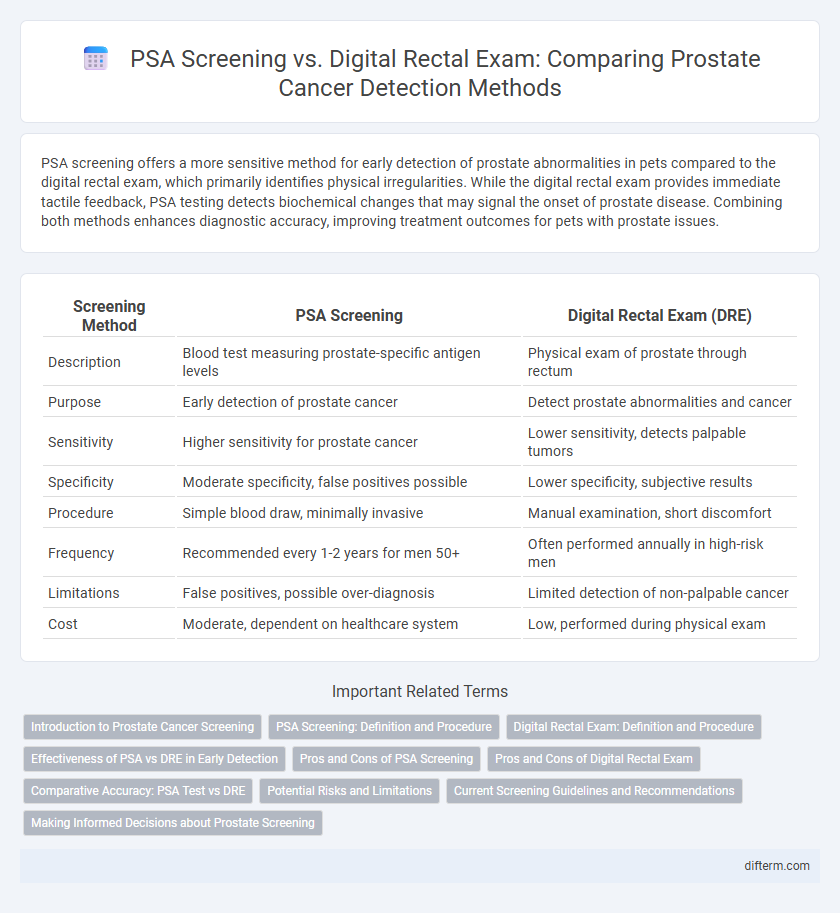PSA screening offers a more sensitive method for early detection of prostate abnormalities in pets compared to the digital rectal exam, which primarily identifies physical irregularities. While the digital rectal exam provides immediate tactile feedback, PSA testing detects biochemical changes that may signal the onset of prostate disease. Combining both methods enhances diagnostic accuracy, improving treatment outcomes for pets with prostate issues.
Table of Comparison
| Screening Method | PSA Screening | Digital Rectal Exam (DRE) |
|---|---|---|
| Description | Blood test measuring prostate-specific antigen levels | Physical exam of prostate through rectum |
| Purpose | Early detection of prostate cancer | Detect prostate abnormalities and cancer |
| Sensitivity | Higher sensitivity for prostate cancer | Lower sensitivity, detects palpable tumors |
| Specificity | Moderate specificity, false positives possible | Lower specificity, subjective results |
| Procedure | Simple blood draw, minimally invasive | Manual examination, short discomfort |
| Frequency | Recommended every 1-2 years for men 50+ | Often performed annually in high-risk men |
| Limitations | False positives, possible over-diagnosis | Limited detection of non-palpable cancer |
| Cost | Moderate, dependent on healthcare system | Low, performed during physical exam |
Introduction to Prostate Cancer Screening
Prostate cancer screening primarily involves two methods: PSA (Prostate-Specific Antigen) testing and Digital Rectal Exam (DRE). PSA screening measures the level of PSA in the blood, serving as an early indicator of prostate abnormalities, while DRE allows direct physical assessment of the prostate gland for irregularities. Combining these screening techniques enhances the detection rate of prostate cancer at an early, more treatable stage.
PSA Screening: Definition and Procedure
PSA screening measures prostate-specific antigen levels in the blood to detect prostate cancer at an early stage. The procedure involves a simple blood test, typically conducted annually for men over 50 or those at higher risk. Elevated PSA levels may prompt further diagnostic tests, distinguishing it from the physical assessment performed in a digital rectal exam.
Digital Rectal Exam: Definition and Procedure
Digital rectal exam (DRE) is a clinical procedure used to evaluate the prostate gland by physically palpating it through the rectal wall, allowing detection of abnormalities such as lumps, enlargement, or tenderness. The examiner inserts a lubricated, gloved finger into the rectum to assess the size, shape, and texture of the prostate, typically lasting only a few minutes and performed during routine prostate health check-ups. DRE complements prostate-specific antigen (PSA) screening by providing immediate tactile information that may indicate conditions like benign prostatic hyperplasia or prostate cancer.
Effectiveness of PSA vs DRE in Early Detection
PSA screening demonstrates higher sensitivity than digital rectal exam (DRE) in detecting early-stage prostate cancer, identifying abnormalities that DRE may miss. Studies show that PSA testing can detect prostate-specific antigen elevations before tumors become palpable, enabling earlier intervention. While DRE remains useful for assessing prostate abnormalities, PSA screening provides a more reliable biomarker for early detection and improving patient prognosis.
Pros and Cons of PSA Screening
PSA screening offers higher sensitivity in detecting early prostate cancer compared to the digital rectal exam (DRE), enabling timely intervention and improved patient outcomes. However, PSA tests are prone to false positives and overdiagnosis, leading to unnecessary biopsies and potential overtreatment. Despite these limitations, PSA screening remains a valuable tool for risk stratification and monitoring in prostate health management.
Pros and Cons of Digital Rectal Exam
Digital rectal exam (DRE) offers a quick, low-cost method for detecting abnormalities in the prostate, including lumps or enlargement, and can be performed during routine check-ups without specialized equipment. However, its sensitivity for detecting early-stage prostate cancer is limited compared to PSA screening, with a higher chance of missing smaller tumors. Patients may experience discomfort or embarrassment during DRE, and false positives can lead to unnecessary follow-up tests and anxiety.
Comparative Accuracy: PSA Test vs DRE
PSA screening demonstrates higher sensitivity than digital rectal exam (DRE), detecting elevated prostate-specific antigen levels indicative of prostate abnormalities earlier. DRE offers direct tactile assessment but exhibits lower accuracy due to operator variability and limited ability to detect non-palpable tumors. Clinical studies reveal PSA testing improves early prostate cancer detection rates compared to DRE, influencing screening guidelines worldwide.
Potential Risks and Limitations
PSA screening carries risks such as false positives, leading to unnecessary biopsies and anxiety, while it may also miss some aggressive cancers, causing false reassurance. Digital rectal exams have limitations including variability in examiner skill and lower sensitivity in detecting prostate abnormalities, which can result in missed diagnoses. Both methods have potential drawbacks, emphasizing the need for informed decision-making and personalized risk assessment in prostate cancer screening.
Current Screening Guidelines and Recommendations
Current screening guidelines emphasize prostate-specific antigen (PSA) testing over digital rectal exam (DRE) for initial prostate cancer detection, given PSA's higher sensitivity in identifying early-stage tumors. The U.S. Preventive Services Task Force recommends individualized PSA screening decisions for men aged 55 to 69, based on risk factors and patient preferences. Routine DRE is no longer advised as a standalone screening tool but may be used adjunctively during clinical evaluation.
Making Informed Decisions about Prostate Screening
Prostate-specific antigen (PSA) screening provides a blood test measurement that can detect early signs of prostate cancer, while digital rectal exam (DRE) allows healthcare providers to physically assess the prostate gland for abnormalities. Combining PSA testing with DRE improves detection accuracy, but both methods have limitations including false positives and overdiagnosis. Understanding the benefits, risks, and individual risk factors such as age, family history, and ethnicity is essential for making informed decisions about prostate cancer screening.
PSA screening vs Digital rectal exam Infographic

 difterm.com
difterm.com